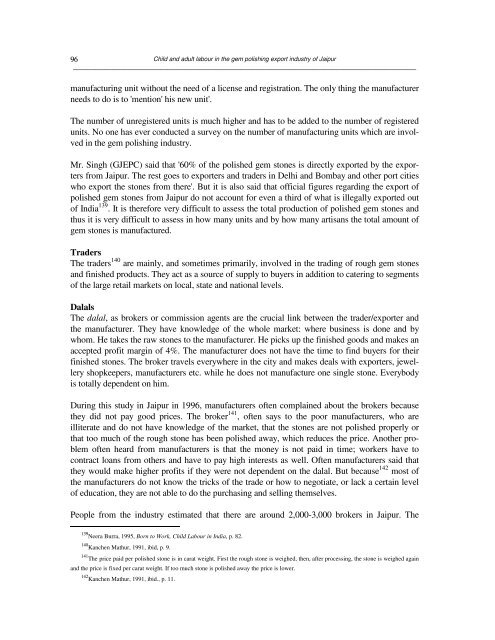You also want an ePaper? Increase the reach of your titles
YUMPU automatically turns print PDFs into web optimized ePapers that Google loves.
96<br />
<strong>Child</strong> <strong>and</strong> <strong>adult</strong> <strong>labour</strong> <strong>in</strong> <strong>the</strong> <strong>gem</strong> polish<strong>in</strong>g <strong>export</strong> <strong>in</strong>dustry <strong>of</strong> Jaipur<br />
──────────────────────────────────────────────────────────────────────────────────────────────<br />
manufactur<strong>in</strong>g unit without <strong>the</strong> need <strong>of</strong> a license <strong>and</strong> registration. The only th<strong>in</strong>g <strong>the</strong> manufacturer<br />
needs to do is to 'mention' his new unit'.<br />
The number <strong>of</strong> unregistered units is much higher <strong>and</strong> has to be added to <strong>the</strong> number <strong>of</strong> registered<br />
units. No one has ever conducted a survey on <strong>the</strong> number <strong>of</strong> manufactur<strong>in</strong>g units which are <strong>in</strong>volved<br />
<strong>in</strong> <strong>the</strong> <strong>gem</strong> polish<strong>in</strong>g <strong>in</strong>dustry.<br />
Mr. S<strong>in</strong>gh (GJEPC) said that '60% <strong>of</strong> <strong>the</strong> polished <strong>gem</strong> stones is directly <strong>export</strong>ed by <strong>the</strong> <strong>export</strong>ers<br />
from Jaipur. The rest goes to <strong>export</strong>ers <strong>and</strong> traders <strong>in</strong> Delhi <strong>and</strong> Bombay <strong>and</strong> o<strong>the</strong>r port cities<br />
who <strong>export</strong> <strong>the</strong> stones from <strong>the</strong>re'. But it is also said that <strong>of</strong>ficial figures regard<strong>in</strong>g <strong>the</strong> <strong>export</strong> <strong>of</strong><br />
polished <strong>gem</strong> stones from Jaipur do not account for even a third <strong>of</strong> what is illegally <strong>export</strong>ed out<br />
<strong>of</strong> <strong>India</strong> 139 . It is <strong>the</strong>refore very difficult to assess <strong>the</strong> total production <strong>of</strong> polished <strong>gem</strong> stones <strong>and</strong><br />
thus it is very difficult to assess <strong>in</strong> how many units <strong>and</strong> by how many artisans <strong>the</strong> total amount <strong>of</strong><br />
<strong>gem</strong> stones is manufactured.<br />
Traders<br />
The traders 140 are ma<strong>in</strong>ly, <strong>and</strong> sometimes primarily, <strong>in</strong>volved <strong>in</strong> <strong>the</strong> trad<strong>in</strong>g <strong>of</strong> rough <strong>gem</strong> stones<br />
<strong>and</strong> f<strong>in</strong>ished products. They act as a source <strong>of</strong> supply to buyers <strong>in</strong> addition to cater<strong>in</strong>g to segments<br />
<strong>of</strong> <strong>the</strong> large retail markets on local, state <strong>and</strong> national levels.<br />
Dalals<br />
The dalal, as brokers or commission agents are <strong>the</strong> crucial l<strong>in</strong>k between <strong>the</strong> trader/<strong>export</strong>er <strong>and</strong><br />
<strong>the</strong> manufacturer. They have knowledge <strong>of</strong> <strong>the</strong> whole market: where bus<strong>in</strong>ess is done <strong>and</strong> by<br />
whom. He takes <strong>the</strong> raw stones to <strong>the</strong> manufacturer. He picks up <strong>the</strong> f<strong>in</strong>ished goods <strong>and</strong> makes an<br />
accepted pr<strong>of</strong>it marg<strong>in</strong> <strong>of</strong> 4%. The manufacturer does not have <strong>the</strong> time to f<strong>in</strong>d buyers for <strong>the</strong>ir<br />
f<strong>in</strong>ished stones. The broker travels everywhere <strong>in</strong> <strong>the</strong> city <strong>and</strong> makes deals with <strong>export</strong>ers, jewellery<br />
shopkeepers, manufacturers etc. while he does not manufacture one s<strong>in</strong>gle stone. Everybody<br />
is totally dependent on him.<br />
Dur<strong>in</strong>g this study <strong>in</strong> Jaipur <strong>in</strong> 1996, manufacturers <strong>of</strong>ten compla<strong>in</strong>ed about <strong>the</strong> brokers because<br />
<strong>the</strong>y did not pay good prices. The broker 141 , <strong>of</strong>ten says to <strong>the</strong> poor manufacturers, who are<br />
illiterate <strong>and</strong> do not have knowledge <strong>of</strong> <strong>the</strong> market, that <strong>the</strong> stones are not polished properly or<br />
that too much <strong>of</strong> <strong>the</strong> rough stone has been polished away, which reduces <strong>the</strong> price. Ano<strong>the</strong>r problem<br />
<strong>of</strong>ten heard from manufacturers is that <strong>the</strong> money is not paid <strong>in</strong> time; workers have to<br />
contract loans from o<strong>the</strong>rs <strong>and</strong> have to pay high <strong>in</strong>terests as well. Often manufacturers said that<br />
<strong>the</strong>y would make higher pr<strong>of</strong>its if <strong>the</strong>y were not dependent on <strong>the</strong> dalal. But because 142 most <strong>of</strong><br />
<strong>the</strong> manufacturers do not know <strong>the</strong> tricks <strong>of</strong> <strong>the</strong> trade or how to negotiate, or lack a certa<strong>in</strong> level<br />
<strong>of</strong> education, <strong>the</strong>y are not able to do <strong>the</strong> purchas<strong>in</strong>g <strong>and</strong> sell<strong>in</strong>g <strong>the</strong>mselves.<br />
People from <strong>the</strong> <strong>in</strong>dustry estimated that <strong>the</strong>re are around 2,000-3,000 brokers <strong>in</strong> Jaipur. The<br />
139 Neera Burra, 1995, Born to Work, <strong>Child</strong> Labour <strong>in</strong> <strong>India</strong>, p. 82.<br />
140 Kanchen Mathur, 1991, ibid, p. 9.<br />
141 The price paid per polished stone is <strong>in</strong> carat weight. First <strong>the</strong> rough stone is weighed, <strong>the</strong>n, after process<strong>in</strong>g, <strong>the</strong> stone is weighed aga<strong>in</strong><br />
<strong>and</strong> <strong>the</strong> price is fixed per carat weight. If too much stone is polished away <strong>the</strong> price is lower.<br />
142 Kanchen Mathur, 1991, ibid., p. 11.


















